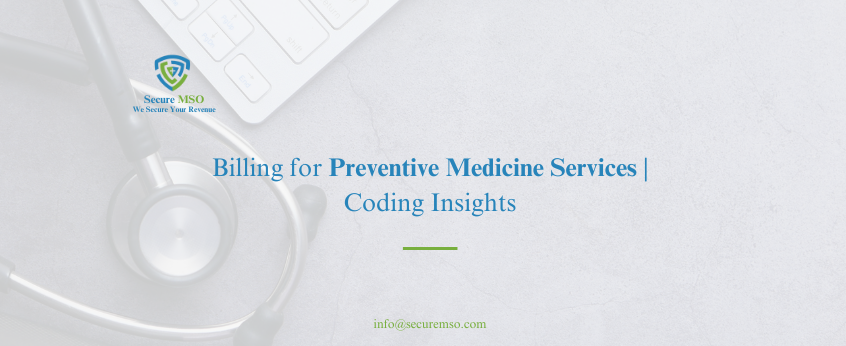Introduction
In today’s healthcare industry, preventive medicine services play a crucial role in maintaining the overall health of patients. These services, which include regular screenings, immunizations, counseling, and other practical health measures, are designed to prevent illnesses, detect diseases early, and promote healthier lifestyles. For healthcare providers, accurately billing for these services is essential not only for ensuring proper reimbursement but also for maintaining compliance with regulatory standards. However, the medical billing and coding process for preventive medicine services can be complex, as it requires a thorough understanding of various coding systems, guidelines, and payer policies. This article delves into the details of medical billing for preventive medicine services, offering coding insights to help providers navigate this essential aspect of healthcare.
Understanding Preventive Medicine Services
Preventive medicine services are distinct from diagnostic or therapeutic services in that they are intended to prevent health issues before they arise or to identify them at an early stage when they are most treatable. These services can be categorized into three primary areas:
Screenings and Assessments: These include routine health assessments, screenings for conditions like hypertension, diabetes, and cancer, and evaluations for mental health and substance use disorders. Screenings are typically age and risk-factor-based, with guidelines provided by organizations such as the U.S. Preventive Services Task Force (USPSTF).
Immunizations: Vaccinations are a critical component of preventive medicine, protecting individuals from infectious diseases. Immunization schedules vary by age group and risk factors, with recommendations issued by bodies like the Centres for Disease Control and Prevention (CDC).
Counselling and Behavioural Interventions: These services involve discussions with patients about lifestyle choices, such as diet, exercise, smoking cessation, and substance use. Counselling can also cover topics like safe sex practices, family planning, and mental health.
The Role of CPT and ICD Codes in Preventive Medicine Billing
Accurate medical billing for preventive medicine services hinges on the correct use of Current Procedural Terminology (CPT) and International Classification of Diseases (ICD) codes. CPT codes, developed by the American Medical Association (AMA), describe the services provided. In contrast, ICD codes, maintained by the World Health Organization (WHO), indicate the diagnosis or reason for the service.
Preventive Medicine CPT Codes
Preventive medicine CPT codes are categorized based on the type of service provided and the patient’s age group. The most common CPT codes for preventive medicine services include:
99381-99387: These codes are used for new patients receiving preventive medicine services. The specific code chosen depends on the patient’s age, with separate codes for infants (under 1 year), early childhood (ages 1-4), late childhood (ages 5-11), adolescents (ages 12-17), and adults (18 and older).
99391-99397: These codes are similar to those mentioned above but are used for established patients receiving preventive services. Again, the code selected corresponds to the patient’s age group.
99401-99412: These codes cover preventive medicine counselling and risk factor reduction interventions, billed in increments of time (15 minutes, 30 minutes, etc.).
G0438 and G0439: These codes are specific to Medicare and are used for annual wellness visits. G0438 is used for the first visit, and G0439 is used for subsequent visits.
ICD Codes for Preventive Medicine
When billing for preventive services, the ICD code should reflect the reason for the visit. Common ICD-10 codes used in preventive medicine include:
Z00.00-Z00.01: General adult medical exams with or without abnormal findings.
Z00.110-Z00.129: Health exams for newborns and infants.
Z23: Encounter for immunization.
Z13.0-Z13.9: Encounter for screening for various conditions (e.g., diabetes, cholesterol disorders, malignancy).
Navigating Preventive Services Billing Challenges
While preventive medicine services are essential, billing for them presents several challenges. These challenges often stem from the nuances in coding, payer-specific guidelines, and differences in coverage between various insurance plans, including Medicare, Medicaid, and private insurers.
Understanding Insurance Coverage and Patient Eligibility
One of the most significant challenges in medical billing for preventive medicine services is understanding insurance coverage and patient eligibility. Coverage for preventive services can vary widely among insurers. For instance, while the Affordable Care Act (ACA) mandates that most insurance plans cover a set of preventive services without cost-sharing, this only applies to services recommended by the USPSTF, CDC, and the Health Resources and Services Administration (HRSA).
Healthcare providers must verify patient eligibility and coverage before delivering preventive services. Failure to do so may result in denied claims or unexpected out-of-pocket costs for patients. Additionally, providers should be aware of any limitations on the frequency of services. For example, certain screenings may be covered only once every few years, depending on the patient’s age and risk factors.
Coding Modifiers and Preventive Medicine
Modifiers are often required when billing for preventive services, particularly when these services are provided in combination with other types of care. For instance, if a preventive service is performed during the same visit as a diagnostic service, the use of modifiers such as 25 (significant, separately identifiable assessment and management service) can help distinguish the preventive service from other billable procedures.
Additionally, some payers may require the use of the 33 modifier to indicate that a service is preventive and, thus, should be covered without cost-sharing under the ACA. This modifier is mainly important when medical billing for services that could be considered either preventive or diagnostic, depending on the context.
Medicare and Preventive Services
Billing for preventive services under Medicare has its own set of rules and challenges. Medicare covers a wide range of preventive services, but the specific coding requirements and coverage rules can differ from those of private insurers. For example, Medicare annual wellness visits (AWVs) are distinct from the standard preventive medicine visits and require the use of specific G codes (G0438 and G0439). Medicare also has stringent documentation requirements for these services, so providers must ensure that they are thoroughly documenting the visit to support the billing.
Another challenge with Medicare is that some preventive services may be covered only if certain criteria are met. For example, Medicare covers the Pneumococcal vaccine only once in a lifetime, except for high-risk patients who may need it more frequently. Providers must be aware of these nuances to avoid claim denials.
Best Practices for Billing Preventive Medicine Services
To navigate the complexities of preventive medicine billing successfully, healthcare providers should adopt the following best practices:
Stay Updated on Coding Guidelines: Preventive medicine coding rules and guidelines are subject to change, particularly with evolving healthcare policies. Providers and billing staff should regularly review updates from the AMA, CMS, and other relevant organizations.
Verify Patient Eligibility and Coverage: Before providing preventive services, always verify the patient’s insurance coverage and eligibility. This step will help prevent denied claims and ensure that patients are aware of any potential costs.
Use Modifiers Appropriately: Be diligent in applying modifiers when necessary to differentiate preventive services from other types of care and to ensure proper reimbursement.
Thorough Documentation: Document all preventive services comprehensively, including the basis for the service, the counseling provided, and any screenings or assessments performed. This documentation is important for supporting claims and audits.
Educate Patients: Patients often need clarification on what is covered under preventive services and what may experience additional costs. Providing clear communication about what to expect can help avoid misunderstandings.
Conclusion
Medical Billing for preventive medicine services requires a deep understanding of coding systems, payer guidelines, and regulatory requirements. By staying informed and accepting best practices, healthcare providers can optimize their billing processes, ensure proper reimbursement, and continue to deliver essential preventive care to their patients. As the healthcare industry continues to change, maintaining a practical approach to preventive medicine billing will be key to satisfying both patient health and the financial health of medical practices.

